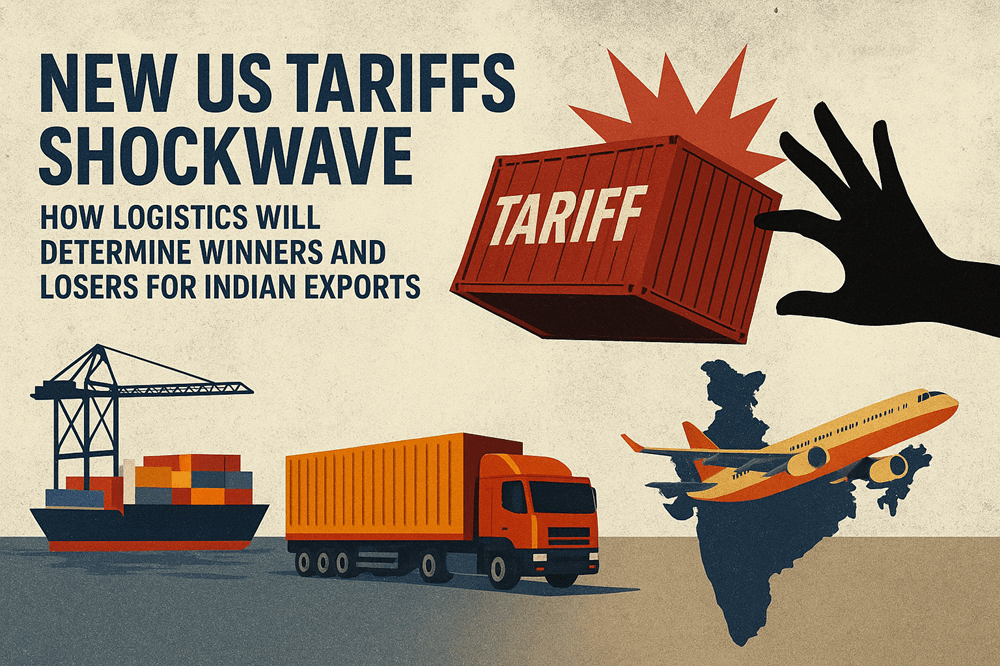
New US Tariffs Shockwave: How Logistics Will Determine Winners and Losers for Indian Exports
On August 28, 2025, the United States significantly increased tariffs on many Indian imports, doubling duties to around 50% for key sectors like textiles, apparel, leather, engineering goods, chemicals, and marine products. This sudden tariff hike, coupled with the elimination of a crucial exemption on small parcels, has sent shockwaves through Indian export sectors and global supply chains with profound repercussions for logistics operations.
What Changed? New US Tariffs and Immediate Market Reactions
The US raised tariffs on export segments that constitute about 55-70% of India’s shipments to America, doubling an earlier 25% duty imposed in August. Simultaneously, the $800 “de minimis” exemption that previously shielded many small B2C parcels from duties was eliminated starting August 29, exposing nearly all US-bound parcels to full customs duty.
These changes triggered last-minute booking cancellations and routing adjustments in ocean freight on India-US lanes. The apparel trade lanes, especially between the National Capital Region and US coasts, have softened, with blank sailings a possible consequence if volumes dwindle further.
Airfreight operators report continued movement of urgent shipments, but many delivery duty paid (DDP) sellers are pausing or recalculating quotes amid the sudden cost jumps. Customs agencies in the US are scrutinizing shipments more closely for origin, valuation, and tariff codes, creating bottlenecks and higher compliance risks.
E-commerce suffers acutely as the removal of de minimis treatment means all parcels now face formal duty assessments, risking backlogs at postal hubs and integrators during the transition.
Defensive and Tactical Logistic Responses
Indian exporters and logistics providers are urgently recalibrating in response. Key measures include:
- Revising quotes with updated duty surcharges.
- Shifting trade terms from DDP to DAP, transferring duty payment responsibility to buyers.
- Delaying shipment gate-ins and consolidating smaller parcels into fewer, larger LCL consignments to reduce per-unit cost hikes.
- Rigorous pre-checks on customs documentation, HS codes, and country of origin to minimize US Customs holds.
- E-commerce sellers moving from postal to faster express and commercial courier services.
- Establishing Importer or Exporter of Record systems and updating checkout tools to reflect full landed costs inclusive of duties.
- Exploring advanced duty management strategies such as Foreign Trade Zones for duty deferral and tariff engineering with expert customs advice.
Sectors heavily reliant on US sales, like Noida and Gurgaon’s textile and leather clusters, report order delays and slowed LCL consolidations, reflecting the tariff storm’s impact.
Long-Term Logistics Landscape Shifts
Beyond short-term disruptions, Indian exporters and logistics companies are diversifying trade routes. Increased focus on markets like Europe, Japan, China, ASEAN, and the Gulf aims to buffer US market volatility.
This rerouting means growing shipment and air cargo volumes to these alternative regions, even as India-US maritime traffic potentially contracts. Air cargo is gaining prominence for high-value and urgent shipments seeking faster, more reliable transit.
However, companies less dependent on the US may seize growth opportunities amid shifting demand, while highly US-exposed firms may face tighter margins.
Sectoral and Economic Impacts
Indian exports to the US, around $87 billion annually, could contract by 10-15%, impacting GDP growth by 0.3-0.5%. Textiles, apparel, leather goods, gems and jewellery, and some engineering goods—many driven by MSMEs—are particularly vulnerable due to increased competition from countries like Vietnam, Bangladesh, and Mexico with lower tariffs.
Conversely, tariff-exempt sectors such as pharmaceuticals, semiconductors, energy products, and critical minerals may maintain steady supply chains.
Currency fluctuations and rising logistics costs further tighten exporters’ margins and working capital needs.
Recommendations: Strengthening Logistics and Policy
To mitigate disruption and tap new opportunities, coordinated action is crucial:
- Fast-track digital integration in customs and cross-border clearance to reduce shipment dwell times and compliance risks.
- Invest in multimodal infrastructure—rail, road, and ports—to connect production hubs with alternative export gateways.
- Establish logistics corridors dedicated to Asia, Europe, and Gulf markets to facilitate trade volume shifts.
- Promote collaborative freight consolidation to help MSMEs stay cost-competitive.
- Advocate tariff rationalization and strengthen bilateral dialogues with global partners.
- Support exporters with real-time market intelligence, flexible financing, and skills training tailored for the evolving trade environment.
Logistics: The Key Driver of India’s Export Success Post-Tariffs
While US tariffs impose a substantial immediate shock, they also mark the start of a transformative phase in India’s export logistics landscape. Success in this new era will hinge on strategic logistics realignment toward diversified markets, enhanced customs efficiency, and robust transport infrastructure.
Companies and policymakers must innovate and collaborate to ensure India not only weathers this storm but emerges stronger in the global trading ecosystem.











